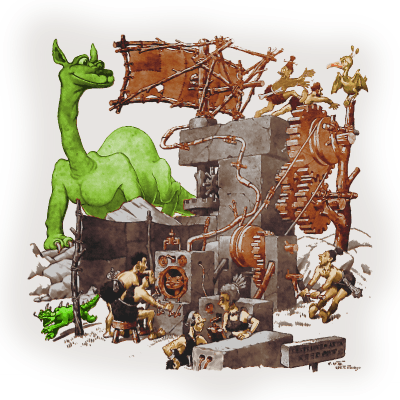Historical Overview

Figure 1: Wall painting from the Technical School of the Air Force in Kaufbeuren (Germany). Beautifully pointing: The administration was in the foreground at that time also.

Figure 1: Wall painting from the Technical School of the Air Force in Kaufbeuren (Germany). Beautifully pointing: The administration was in the foreground at that time also.
Historical Overview
Neither a single nation nor a single person can say that the discovery and development of radar technology was his (or its) own invention. One must see the knowledge about “Radar” than an accumulation of many developments and improvements, in which any scientists from several nations took part in parallel. In the past, there are nevertheless some milestones, with the discovery of important basic knowledge and important inventions:
1865 The Scottish physicist James Clerk Maxwell presents his “Theory of the Electromagnetic Field” (description of the electromagnetic waves and their propagation) He demonstrated that electric and magnetic fields travel through space in the form of waves, and at the constant speed of light.
1886 The German physicist Heinrich Rudolf Hertz discovered electromagnetic waves, thus demonstrating the Maxwell theory.
1897 The Italian inventor Guglielmo Marconi achieved the first long distance transmission of electromagnetic waves. In his first experiments he used a wire to a wooden pole. In Italian a tent pole is known as l'antenna centrale, and the pole with a wire alongside it used as an aerial was simply called l'antenna. Today Marconi is known as pioneer of radio communication.
1900 Nicola Tesla suggested that the reflection of electromagnetic waves could be used for detecting of moving metallic objects.
1904 The German engineer Christian Hülsmeyer invents the "telemobiloscope" for a traffic monitoring on the water in poor visibility. This is the first practical radar test. Hülsmeyer apply his invention for a patent in Germany, France and the United Kingdom.
1921 The invention of the Magnetron as an efficient transmitting tube by the US-american physicist Albert Wallace Hull.
1922 The American electrical engineers Albert H. Taylor and Leo C. Young of the Naval Research Laboratory (USA) locate a wooden ship for the first time.
1930 Lawrence A. Hyland (also of the Naval Research Laboratory), locates an aircraft for the first time.
1931 In Britain the first known proposal for radar system came from William A. S. Butement and P. E. Pollard in January 1931. They equipped a ship with radar. As antennae were used parabolic dishes with horn radiator. Although their equipment produced short-range results the work was abandoned for lack of government support.
1933 On the basis of the in 1931 from himself invented sonar, Rudolph Kühnhold presented a so-called “Funkmessgerät”. It worked on a wavelength of 48 cm and the transmitter had a power of about 40 Watts. From these tests, the Freya-radar was developed, which was produced in series beginning in 1938.
1935 Robert Watson-Watt (later: Sir Robert) suggested that radio waves might be used to detect aircraft at a distance and outlined a means of doing so. Intensive research began and by 1939 Britain possessed a defensive chain of highly secret Radio Direction Finding (RDF) stations.
1936 The development of the Klystron by the technicians George F. Metcalf and William C. Hahn, both General Electric. This will be an important component in radar units as an amplifier or an oscillator tube.
1939 Two engineers from the university in Birmingham, John Turton Randall und Henry Albert Howard Boot built a small but powerful radar using a Multicavity-Magnetron. The B–17 airplanes were fitted with this radar. Now they could find and thus combat the German submarines in the night and in fog.
1940 Different radar equipments are developed in the USA, Russia, Germany, France and Japan.
Driven by general war events and the development of the Air Force to major branch of service, the radar technology undergoes a strong development boost during the World War II, and radar sets were used during the "Cold War" in large numbers along the inner German border.
